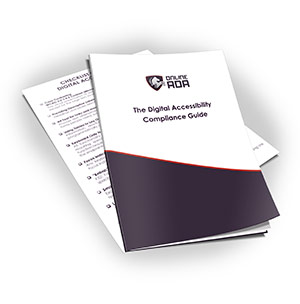So you’ve got a website? Most businesses and organizations do. And since those websites are considered public domain, they must be accessible by people who have disabilities as well as by people who don’t. Just like a restaurant, a website where someone accesses products, services or information must be accessible by all.
To that end, a Section 508 Compliance Checklist will help you be aware of the federal standard for website accessibility. The following checklist is just a partial list of some of the major requirements of Section 508 compliance. If this Section 508 compliance checklist seems overwhelming for you, get in touch with us!
Our agency has implemented two solutions to help solve this problem. We have created the ADA Plugin, which is an affordable option for people who manage websites and are confident in making the fixes themselves. The ADA Plugin scans a website for Section 508 Accessibility compliance issues, flags them, and connects them with the standard’s requirements so they can easily be fixed. The second solution is to hire our agency to run the scan for you and fix any and all issues your site may be experiencing.
With that option, your site is thoroughly reviewed by someone whose job it is to understand the complex technical requirements of Section 508 Accessibility and fix them. You will be assured that your site is compliant from the ground up, and you can more easily maintain that compliance as time goes on.
If the answer to any of these questions is No, then your site would not pass a Section 508 compliance audit.
Here’s Your Section 508 Compliance Checklist
- Do images have alt attributes?
- Does the alternate text convey contextual relevance to the page it is on?
- Do your images contain text? In other words, does text content contained in images disappear when images are not available?
- Do noframes elements have appropriate equivalent or alternative content for user agents that do not support frames?
- Is a full text transcript provided for all pre-recorded audio and/or video?
- Is information conveyed by color also conveyed by context, markup, graphic coding, or other means? In other words, if a person were unable to see color, would they be able to understand the required actions?
- Does a contrast ratio of at least 4.5:1 exist between text, and images of text, and background behind the text?
- Is a correct contrast ratio maintained when CSS is disabled?
- Are links distinguished from surrounding text with sufficient color contrast?
- When the link is activated is the contrast noticeable?
- With CSS disabled, are headings, paragraphs, and lists obvious and sensible?
- With CSS disabled, is most text, other than logos and banners, rendered in text rather than images?
- When tables are used for layout, does the content linearize properly when layout tables are turned off?
- For tables containing data, do the elements appropriately define every row and/or every column headers?
- For tables containing data, is the summary attribute used to explain the meaning of the table if it is not otherwise evident from context?
- Does each frame and iframe element have a meaningful title attribute?
- Do all documents have a text-only version? If so, does it meet all Section 508 criteria and contain the same exact information as the original document?
- Is any content or functionality provided by JavaScript through mouse action also provided through keyboard-triggered event handlers?
- Are links provided to any special readers or plug-ins that are required to interpret page content?
- Do form error messages identify the error(s) to the user and describe them to the user in text?


